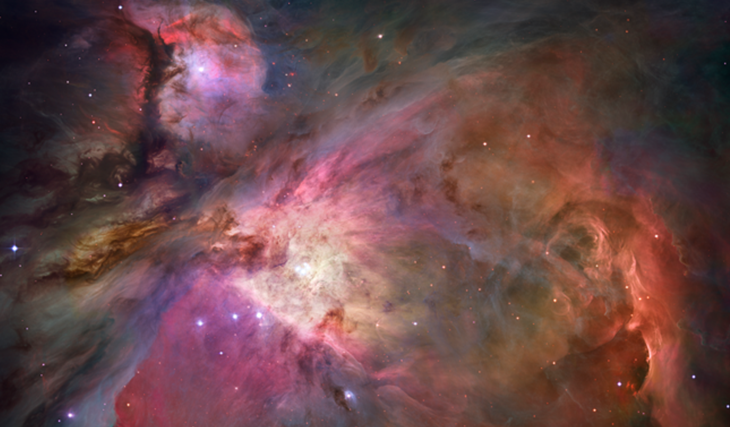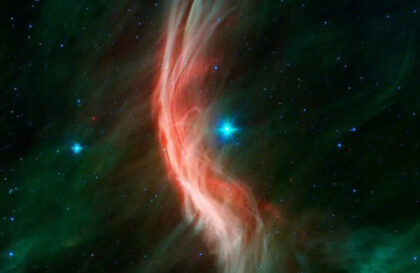Interstellar gas can be cold (a few degrees above absolute zero) or hot (a million degrees or more). It depends on where it is located. It may contain acetic acid, glycolaldehyde – a simple sugar; ammonia, which is used in cleaning products; acetylene, which is a fuel for gas burners; ethylene glycol (an antifreeze ingredient), benzene (an ingredient in varnishes and dyes).
The Small Magellanic Cloud, like all galaxies, harbors many different sources of heat. These entities keep the extremely hot gases from supernovae far above the temperature of the 3 kelvin background radiation. Credit: NASA/JPL-Caltech/K. Gordon (STScI)
Gas near hot stars
Astronomical photos often show interstellar gas near hot stars glowing red due to the H-alpha line of hydrogen. Hot stars heat the gas to ~10,000 K and ionize hydrogen with their ultraviolet radiation, which then recombines, recapturing a free electron. Then, the cycle repeats. However, hydrogen is predominantly in an ionized state near a hot star.
Hydrogen, as the main component of mech-stellar gas, determines the state of cosmic regions: the cloud of ionized gas is neutral (H I) or ionized, and hydrogen has lost one electron (H II). Roman numerals in the names indicate the level of ionization of atoms.
Electrons captured by hydrogen nuclei pass through the levels, emitting light. This process, which converts UV radiation into visible light, is called fluorescence. Interstellar gas also includes other elements that ionize and emit light near hot stars, like hydrogen. The red line of hydrogen dominates, making the H II regions red. Fluorescent lamps on Earth work on the same principle. When the current is turned on, the electrons collide with mercury vapor. When they move to lower energy levels, they emit ultraviolet light, which is converted into white visible by the phosphor coating of the lamp bulb.
Clouds of neutral hydrogen
Hot stars that create H II regions are rare, so most interstellar matter consists of neutral rather than ionized hydrogen. Neutral hydrogen does not emit visible light at typical interstellar temperatures. To detect it, absorption lines of other elements in the spectra of bright sources such as stars and galaxies are used. Calcium and sodium create strong absorption lines that allow you to find neutral hydrogen and other elements.
The first evidence of interstellar absorption was discovered in 1904 when lines in the spectrum of a binary star that were not shifted by the Doppler effect and were surprisingly narrow were found. This indicated the existence of cold, low-pressure gas located between the Earth and the star. But this did not prove that it was hydrogen.
In 1944, Hendrik van de Hulst predicted the existence of a 21-centimeter radio emission line from hydrogen, arising not from electron jumps between levels but from electron “flip.”
Formation of the 21 cm line: When the electron in a hydrogen atom is in the orbit closest to the nucleus, the proton and electron can spin either (a) in the same direction or (b) in opposite directions. When an electron flips, the atom gains or loses a small amount of energy by absorbing or emitting electromagnetic energy at a wavelength of 21 centimeters. Credit: courses.lumenlearning.com
Neutral hydrogen atoms can gain small amounts of energy through collisions with other hydrogen atoms or free electrons. Such collisions are infrequent in the rarefied gases of interstellar space. An individual atom can wait centuries before such a collision aligns the spins of its proton and electron. However, over many millions of years, a significant fraction of the hydrogen atoms become excited during collisions. In cold space, this is about the same excitation that an atom on Earth usually experiences.
Harold Ewan (1922–2015) and Edward Purcell (1912–1997): We see Harold Ewen in 1952 working with the horn antenna (on top of the physics laboratory at Harvard) that first detected interstellar 21 cm radiation. The inset shows Edward Purcell, winner of the 1952 Nobel Prize in Physics, a few years later. Credit: modification of NRAO’s work.
The excited atom can subsequently lose its excess energy either by colliding with another particle or by emitting a radio wave 21 centimeters long. If there are no collisions, an excited hydrogen atom will wait, on average, about 10 million years before emitting a photon and returning to its lowest energy state.
In 1951, radio emission from hydrogen was discovered at a wavelength of 21 cm. The first discovery was made by American physicists Harold Ewen and Edward Purcell after a fire destroyed a Dutch instrument. This discovery, confirmed by Dutch and Australian astronomers, and the subsequent detection of other radio lines made it possible to map neutral gas in our Galaxy and beyond at various wavelengths.
Modern radio observations indicate that most of the neutral hydrogen in our Galaxy is contained in an extremely flat layer less than 300 light-years thick that extends across the entire disk of the Milky Way Galaxy. The density of this gas varies from about 0.1 to about 100 atoms per cm 3. It exists over a wide temperature range: from about 100 K (–173 °C) to about 8000 K. These regions of warm and cold gas alternate, and the density and temperature at any specific point in space constantly change.
Ultra-hot interstellar gas
Vela Supernova Remnant: About 11,000 years ago, a dying star in the constellation of Vela exploded, becoming as bright as the full moon in Earth’s skies. You can see the faint rounded filaments from that explosion in the center of this colorful image. The edges of the remnant are colliding with the interstellar medium, heating the gas they plow through to temperatures of millions of K. Telescopes in space also reveal a glowing sphere of X-ray radiation from the remnant. (credit: Digitized Sky Survey, ESA/ESO/NASA FITS Liberator, Davide De Martin)
The discovery of super-hot interstellar gas with a temperature of a million degrees came as a surprise to astronomers. Previously, they assumed that the space between the stars is filled with relatively cool gas. Emission at these temperatures was discovered by ultraviolet and X-ray observatories in space, which detected interstellar lines from highly ionized oxygen and gas bubbles emitting in the X-ray range.
Supernova explosions, which occur at the end of the lives of massive stars, are the source of high temperatures in interstellar space. They eject gas at speeds of up to tens of thousands of kilometers per second (about 30% of the speed of light), which, colliding with the surrounding gas, heats it to millions of degrees.
Astronomers estimate that a supernova explodes somewhere in the Galaxy approximately every 100 years. On average, tremors caused by supernovae sweep through any point in the Galaxy approximately once every few million years. These impacts fill part of interstellar space with gas at millions of degrees and continually disturb the cooler gas, keeping it in constant turbulent motion.
Molecular clouds
Disappearing Clouds in Carina. Credit: Hubble Heritage Team (STScI/AURA), N. Walborn (STScI) & R. Barb (La Plata Obs.), NASA
The detection of molecules in space began with simple molecules creating absorptions in stellar spectra and expanded to more complex molecules with radio and infrared spectrometers. Atoms and molecules leave unique spectral fingerprints, and laboratory experiments have identified these fingerprints for many molecules, helping astronomers identify them in the interstellar medium.
The presence of complex molecules in space seemed strange at first due to ultraviolet radiation destroying them. But interstellar dust that forms dark clouds blocks this radiation, allowing the molecules to survive. Giant molecular clouds, formed by gravity, contain a lot of molecular hydrogen (H2) and other complex molecules in smaller quantities.
Giant molecular clouds, numbering hundreds to thousands of atoms per cubic centimeter, contain up to 30% of the gas mass of the Milky Way despite their small fraction of volume. By blocking ultraviolet light, they maintain a low temperature of about 10 K (-2630 C) and are an arena for star formation.
In the dark regions of space, protected from starlight, molecules form through chemical reactions in gas and dust particles. Among the many compounds detected are water, carbon monoxide, and ammonia. CO, abundant in interstellar space, is a tracer for studying molecular clouds since molecular hydrogen H2 is difficult to detect directly due to its low temperature.
The more complex molecules discovered by astronomers are mostly combinations of hydrogen, oxygen, carbon, nitrogen, and sulfur atoms. Many of these molecules are organic (those that contain carbon and are related to the carbon chemistry of life on Earth). These include formaldehyde (used to preserve living tissue), alcohol, and antifreeze.
In 1996, astronomers found acetic acid and glycolaldehyde, a simple sugar, in the constellation Sagittarius. The largest molecules in space are fullerenes, consisting of 60-70 carbon atoms. Molecules of ammonia, which is used in cleaning products, acetylene, a fuel for gas burners, ethylene glycol (an antifreeze ingredient), and benzene (an ingredient in varnishes and dyes), were detected.
Interstellar clouds contain the molecules cyanoacetylene (HC 3 N) and acetaldehyde (CH 3 CHO), precursors to amino acids, the basis of living organisms on Earth. This confirms the possibility of forming the chemical foundations of life in different conditions of the Universe and helps to understand the processes that could precede the origin of life on our planet.
Banner image: NASA, ESA, M. Robberto (Space Telescope Science Institute/ESA) and the Hubble Space Telescope Orion Treasury Project Team
Image credit:
https://hubblesite.org
https://www.astronomy.com
https://courses.lumenlearning.com
https://supernova.eso.org
https://apod.nasa.gov


